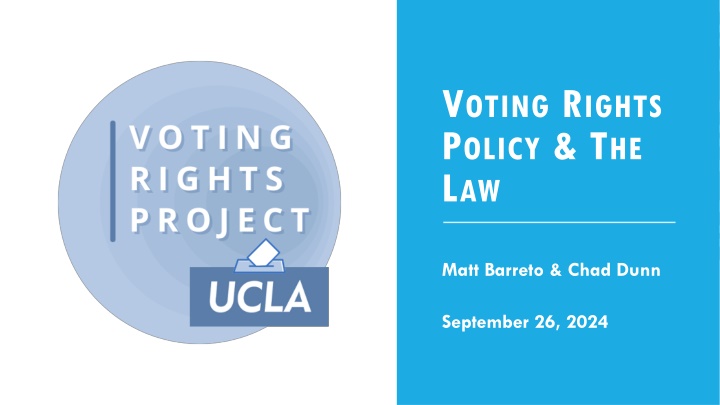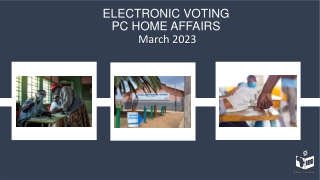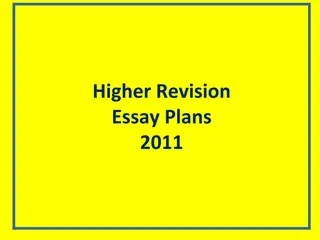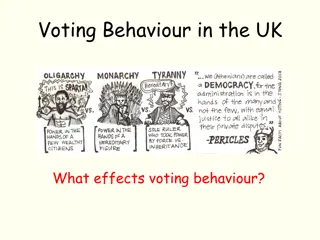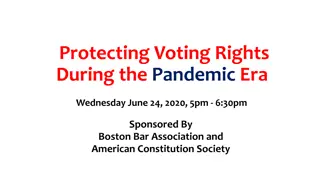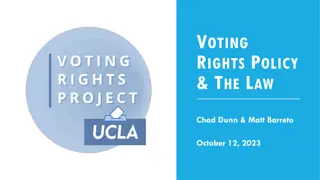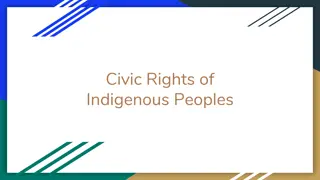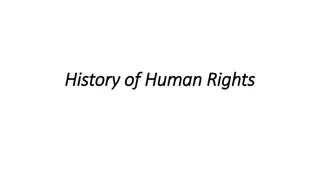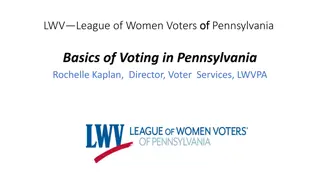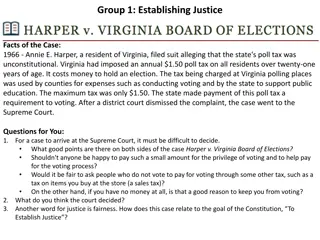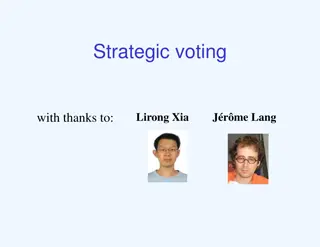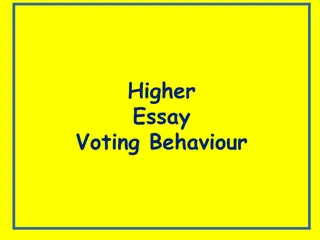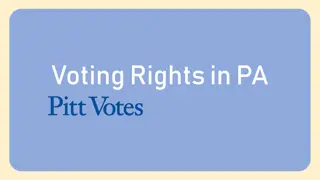Voting Rights Policy & the Law Overview
Year-long course focusing on social science research and civil rights regarding voting rights. Students learn history, legal interpretations, and practical applications of voting rights acts. Cases worked on involve proof elements for voting rights challenges and potential lawsuits against jurisdictions violating voting rights acts. Current voting rights project cases are also highlighted, along with key components of the Federal Voting Rights Act.
Download Presentation

Please find below an Image/Link to download the presentation.
The content on the website is provided AS IS for your information and personal use only. It may not be sold, licensed, or shared on other websites without obtaining consent from the author.If you encounter any issues during the download, it is possible that the publisher has removed the file from their server.
You are allowed to download the files provided on this website for personal or commercial use, subject to the condition that they are used lawfully. All files are the property of their respective owners.
The content on the website is provided AS IS for your information and personal use only. It may not be sold, licensed, or shared on other websites without obtaining consent from the author.
E N D
Presentation Transcript
VOTING RIGHTS POLICY & THE LAW Matt Barreto & Chad Dunn September 26, 2024
COURSE OVERVIEW Year-long course across Fall, Winter (Spring, Summer) Full class meets every Thursday Joined by Law 832 students (Semester schedule) Taught from the perspective of social science research, and civil rights and voting rights Cases we have worked on Learn the history, legal interpretations, practical application of VRA, CVRA, WVRA + other states 2
COURSE OVERVIEW Learn the elements of proof of a successful voting rights challenge Narrow down jurisdictions of interest Students are going to make the case write a complaint for why their jurisdiction violates the VRA or CVRA or WVRA or VAVRA or NYVRA Eventually consider a lawsuit against unlawful jurisdictions 3
VOTING RIGHTS PROJECT CASES TODAY Portugal v. Franklin County Public Utility District, et al., at-large election Washington State Court Soto Palmer v. State of Washington, Statewide Redistricting United States Court of Appeals for the Ninth Circuit Petteway v. Galveston County, et al., constitutional claim for intentional destruction of performing minority district United States District Court for the Southern District of Texas, Galveston Division. Aquino, et al. v. Hazleton Area School District at-large election United States District Court for the Middle District of Pennsylvania In re Otero County, New Mexico, claim under state law for failure to comply with mandatory election results on a measure to transition to single member districts New Mexico Supreme Court Developing cases in NY, NC, WA, CO and elsewhere 4
THE FEDERAL VOTING RIGHTS ACT 15th Amendment: the right to vote shall not be denied or abridged on the basis of race, color or previous condition of servitude 1964 Civil Rights Act: Title I calls for any qualifications for voter registration to be applied equally to all, prohibits a voter from being rejected for non-material errors on an application, and outlines specific requirements for literacy tests. 5
THE FEDERAL VOTING RIGHTS ACT 1964 CRA had no enforcement mechanism of federal oversight on the acts requirements 1965 Voting Rights Act, Section 2 (a) No voting qualification or prerequisite to voting or standard, practice, or procedure shall be imposed or applied by any State or political subdivision in a manner which results in a denial or abridgement of the right of any citizen of the United States to vote on account of race or color, or in contravention of the guarantees set forth in section 6
THE FEDERAL VOTING RIGHTS ACT 1965 VRA Section 2 (b) A violation of subsection (a) is established if, based on the totality of circumstances, it is shown that the political processes leading to nomination or election in the State or political subdivision are not equally open to participation by members of a class of citizens protected by subsection (a) in that its members have less opportunity than other members of the electorate to participate in the political process and to elect representatives of their choice. The extent to which members of a protected class have been elected to office in the State or political subdivision is one circumstance which may be considered: Provided, That nothing in this section establishes a right to have members of a protected class elected in numbers equal to their proportion in the population. 7
THE FEDERAL VOTING RIGHTS ACT 1965 VRA Section 2 (b) A violation of subsection (a) is established if, based on the totality of circumstances, it is shown that the political processes leading to nomination or election in the State or political subdivision are not equally open to participation by members of a class of citizens protected by subsection (a) in that its members have less opportunity than other members of the electorate to participate in the political process and to elect representatives of their choice. The extent to which members of a protected class have been elected to office in the State or political subdivision is one circumstance which may be considered: Provided, That nothing in this section establishes a right to have members of a protected class elected in numbers equal to their proportion in the population. 8
REPRESENTATIVES OF THEIR CHOICE How do we determine representatives of choice? What is racially polarized voting ? What is a community of interest ? 9
REPRESENTATIVES OF THEIR CHOICE 100% Galveston County Texas, Election for County Judge 2022 90% 80% % vote for candidate 70% % for Henry (CVAP) 60% 50% 40% 30% 20% 10% 0% 0% 10% 20% 30% 40% 50% 60% 70% 80% 90% 100% % White in precinct 10
REPRESENTATIVES OF THEIR CHOICE 100% Galveston County Texas, Election for County Judge 2022 90% Best fit regression line 80% % vote for candidate 70% % for Henry (CVAP) 60% 50% 40% 30% 20% 10% 0% 0% 10% 20% 30% 40% 50% 60% 70% 80% 90% 100% % White in precinct 11
VRA SECTION 5 Preclearance SEC. 5. Whenever a State or political subdivision with respect to which the prohibitions set forth in section 4(a) are in effect shall enact or seek to administer any voting qualification or prerequisite to voting, or standard, practice, or procedure with respect to voting different from that in force or effect on November 1, 1964, such State or subdivision may institute an action in the United States District Court for the District of Columbia for a declaratory judgment that such qualification, prerequisite, standard, practice, or procedure does not have the purpose and will not have the effect of denying or abridging the right to vote on account of race or color, and unless and until the court enters such judgment no person shall be denied the right to vote for failure to comply with such qualification, prerequisite, standard, practice, or procedure: 12
VRA SECTION 5 Shelby v. Holder (2013) Formula in Section 4b was outdated Therefore Section 5 preclearance not in effect If Congress had started from scratch in 2006, it plainly could not have enacted the present coverage formula. According to the Court, Regardless of how to look at the record no one can fairly say that it shows anything approaching the pervasive, flagrant, widespread, and rampant discrimination that faced Congress in 1965, and that clearly distinguished the covered jurisdictions from the rest of the nation. 13
VRA SECTION 5 Shelby v. Holder (2013) Dissent argued that decades of SCOTUS decisions say they should defer to Congress, which had compiled extensive record of contemporaneous discriminatory voting rights practices [t]hrowing out preclearance when it has worked and is continuing to work to stop discriminatory changes is like throwing away your umbrella in a rainstorm because you are not getting wet. 14
SECTION 203 Amended in 1975 and added Section 203 Whenever any State or political subdivision [covered by the section] provides registration or voting notices, forms, instructions, assistance, or other materials or information relating to the electoral process, including ballots, it shall provide them in the language of the applicable minority group as well as in the English language. 15
2023 ALABAMA LAWSUIT MILIGAN To What Degree Can Race be Considered Majority: When it comes to considering race in the context of districting, we have made clear that there is a difference between being aware of racial considerations and being motivated by them. The former is permissible; the latter is usually not [W]e held over 40 years ago that, even if 1 of the [Fifteenth] Amendment prohibits only purposeful discrimination, the prior decisions of this Court foreclose any argument that Congress may not, pursuant to 2 [of the Fifteenth Amendment] outlaw voting practices that are discriminatory in effect. . . . [T]this Court and the lower federal courts have repeatedly applied the effects test of 2 as interpreted in Gingles and, under certain circumstances, have authorized race-based redistricting as a remedy for state districting maps that violate 2. Race Blind Jurisprudence? Dissent: Stare decisis did not save separate but equal, despite its repeated reaffirmation in this Court and the pervasive reliance States had placed upon it for decades. It should not rescue modern-day forms of de jure racial balkanization which, as these cases show, is exactly where our 2 vote-dilution jurisprudence has led. 16
2023 ALABAMA LAWSUIT MILIGAN Does the VRA have an expiration date? Kavanaugh: "Alabama asserts that 2, as construed by Gingles to require race-based redistricting in certain circumstances, exceeds Congress s remedial or preventive authority under the Fourteenth and Fifteenth Amendments. As the Court explains, the constitutional argument presented by Alabama is not persuasive in light of the Court s precedents. See City of Rome v. United States, 446 U. S. 156, 177 178 (1980). JUSTICE THOMAS notes, however, that even if Congress in 1982 could constitutionally authorize race-based redistricting under 2 for some period of time, the authority to conduct race-based redistricting cannot extend indefinitely into the future. But Alabama did not raise that temporal argument in this Court, and I therefore would not consider it at this time. 17
THE CALIFORNIA VOTING RIGHTS ACT Federal VRA has been interpreted more narrowly California Voting Rights Act signed in 2002 Allows civil rights groups to bring lawsuits under California law against at-large jurisdictions If they can prove the at-large system is preventing minority groups from getting elected to office Has resulted in considerable increases in Latino elected officials at local level in California 19
WASHINGTON, NEW YORK AND MORE Washington state 2018 [link to law] The legislature finds that electoral systems that deny race, color, or language minority groups an equal opportunity to elect candidates of their choice are inconsistent with the right to free and equal elections as provided by the Washington state Constitution Virginia 2021 New York 2022 UCLA VRP Model State Code 20
NEXT STEPS FOR THIS CLASS Read court decisions: Gingles v. Thornburg Mobile v. Bolden What jurisdictions are not in compliance with the Federal or California Voting Rights Act? Lack of minority representation Lack of language assistance (Section 203) Example: Franklin County, WA Dodge City, KS 21
THANK YOU! Prof. Barreto: matt@uclavrp.org Prof. Dunn: chad@uclavrp.org
